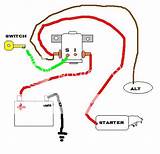How To Wire Ford Starter Solenoid
Ronan Farrow
Apr 03, 2025 · 3 min read

Table of Contents
How to Wire a Ford Starter Solenoid: A Comprehensive Guide
Wiring a Ford starter solenoid might seem daunting, but with a clear understanding and the right tools, it's a manageable task. This guide provides a step-by-step process, focusing on safety and accuracy. Remember, working with car electrical systems requires caution. Always disconnect the negative battery terminal before starting any work.
Understanding the Ford Starter Solenoid
The starter solenoid is a crucial component in your Ford's starting system. It's an electromagnetic switch that bridges the high-current circuit between the battery and the starter motor. When you turn the ignition key, the solenoid activates, completing the circuit and cranking the engine. Understanding its role is vital for proper wiring.
Identifying the Solenoid and its Terminals
The starter solenoid is typically located near the starter motor, usually secured to the engine block or firewall. It's a relatively small, cylindrical unit with several large terminals (usually two or three). These terminals are marked, often with letters like “S,” “I,” and “B,” or may be color-coded. Identifying these correctly is paramount.
S(Start): This terminal receives power from the ignition switch.I(Ignition): This terminal receives battery voltage (large gauge wire).B(Battery): This is the main power terminal connecting to the starter motor (very large gauge wire).
Tools and Materials Required
Before you begin, gather the necessary tools and materials to ensure a smooth process.
- Wrench Set: To disconnect and reconnect battery terminals and starter motor wiring.
- Screwdriver Set: For removing solenoid mounting bolts if necessary.
- Battery Terminal Cleaner: To ensure a clean connection.
- Test Light or Multimeter: To verify circuit continuity and voltage.
- Replacement Starter Solenoid (if needed): A new solenoid is a good idea if yours is faulty.
- Electrical Tape (optional): For securing wire connections.
- Gloves: To prevent shocks and protect your hands.
- Safety Glasses: Protect your eyes from sparks or debris.
Step-by-Step Wiring Procedure
Now, let's walk through the wiring process step-by-step:
Step 1: Disconnect the Battery
This is crucial. Disconnect the negative (-) terminal of your Ford's battery. This prevents accidental shorts and protects you from electric shock.
Step 2: Access the Starter Solenoid
Locate the starter solenoid, usually near the starter motor. You might need to remove some components to access it fully. Take photos along the way so you know where everything goes back!
Step 3: Inspect Existing Wiring
Carefully examine the existing wiring. Note the connection points of the large and small wires to the solenoid terminals. This will guide you in the reconnection process.
Step 4: Connect the Battery Cable
Attach the thick, high-current battery cable (usually red) to the B terminal (Battery). Ensure a clean, tight connection.
Step 5: Connect the Ignition Wire
Connect the smaller wire from the ignition switch to the S terminal (Start). This wire carries the signal to activate the solenoid. Again, ensure a secure connection.
Step 6: Connect the Battery Cable to the Starter
Connect the other end of the heavy battery cable to the starter motor.
Step 7: Reconnect the Battery
Reconnect the negative (-) battery terminal.
Step 8: Test the System
Turn the ignition key to the "Start" position. Your Ford engine should crank. If it doesn't, double-check all connections for tightness and proper placement.
Troubleshooting Common Issues
If your Ford still doesn't start after wiring the solenoid, consider these troubleshooting steps:
- Check Battery Voltage: Ensure your battery has sufficient charge.
- Inspect Wiring for Damage: Look for any broken, frayed, or corroded wires.
- Test the Starter Motor: A faulty starter motor can also prevent the engine from cranking.
- Verify Ignition Switch Functionality: A problem with the ignition switch can prevent the solenoid from receiving the start signal.
Conclusion
Wiring a Ford starter solenoid is achievable with careful planning and execution. By following these steps and remembering safety precautions, you'll be back on the road in no time. If you encounter persistent issues, seeking professional assistance is always recommended. Remember to always refer to your vehicle's specific repair manual for detailed diagrams and instructions.
Featured Posts
Also read the following articles
| Article Title | Date |
|---|---|
| Howa 1500 Scope Base Same As Remington 700 | Apr 03, 2025 |
| Determine How A Router Makes A Forwarding Decision By Default | Apr 03, 2025 |
| 1860 Howe Ave Sacramento Ca 95825 | Apr 03, 2025 |
| Do I Have To Know How To Swim To Snorkel | Apr 03, 2025 |
| How Big Is 15mm Round | Apr 03, 2025 |
Latest Posts
-
How Do Boat Trailer Surge Brakes Work
Apr 04, 2025
-
How Do Bees Get Inside The House
Apr 04, 2025
-
How Do Baptists Celebrate Easter
Apr 04, 2025
-
How Do Baptist Celebrate Easter
Apr 04, 2025
-
How Do Art Auctions Work
Apr 04, 2025
Thank you for visiting our website which covers about How To Wire Ford Starter Solenoid . We hope the information provided has been useful to you. Feel free to contact us if you have any questions or need further assistance. See you next time and don't miss to bookmark.
